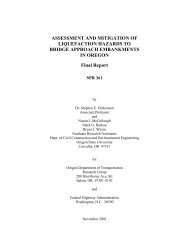Oregon Balance of State HIV/AIDS Housing & Services Systems ...
Oregon Balance of State HIV/AIDS Housing & Services Systems ...
Oregon Balance of State HIV/AIDS Housing & Services Systems ...
Create successful ePaper yourself
Turn your PDF publications into a flip-book with our unique Google optimized e-Paper software.
<strong>Oregon</strong> <strong>HIV</strong>/<strong>AIDS</strong> <strong>Housing</strong> and <strong>Services</strong> <strong>Systems</strong> Integration Plan—Appendices A-45<br />
GOALS & DESCRIPTIONS<br />
Negotiated set-asides <strong>of</strong> units for<br />
PLWHA in mainstream affordable<br />
housing projects<br />
Best in projects already developed<br />
with rents affordable to PLWHA, or<br />
when <strong>AIDS</strong> service organizations can<br />
contribute debt-free funding (such as<br />
HOPWA)<br />
A long-term lease agreement with a<br />
property manager in which a service<br />
organization funds a rent reserve to<br />
pay the difference between market rent<br />
and the amount that consumers can<br />
pay<br />
Best when market rents are not<br />
affordable and landlords are willing to<br />
enter long-term agreements<br />
A service organization leases units that<br />
are then sub-leased at an affordable<br />
cost to PLWHA<br />
Best in communities with active rental<br />
markets in healthy neighborhoods with<br />
access to support services<br />
ASSISTANCE TYPES &<br />
HOPWA–ELIGIBLE USES<br />
Set-Asides in Other <strong>Housing</strong><br />
Projects<br />
- Can fund acquisition, rehab,<br />
etc. (new construction for SRO<br />
and group homes only)<br />
-Can fund facility operations<br />
Lease Buy-Downs<br />
- Rent reserves are not<br />
HOPWA-eligible<br />
- Can fund monthly lease,<br />
operations, and repair costs<br />
Master Leasing<br />
-Can fund monthly lease,<br />
operations, and repair costs<br />
ADVANTAGES DISADVANTAGES<br />
- Can help experienced<br />
developers to create new longterm<br />
housing capacity<br />
- Can be quicker and more<br />
economically efficient than<br />
dedicated development<br />
- Can be long-term<br />
- Residents can integrate into<br />
community<br />
- Can be economically efficient<br />
and ensure stability without<br />
ongoing subsidy<br />
- Less complex than facilitybased<br />
assistance<br />
- Residents can integrate into the<br />
community<br />
- Can allow organizations to<br />
place consumers quickly<br />
- Community acceptance issues<br />
can <strong>of</strong>ten be avoided<br />
- Residents can integrate into the<br />
community<br />
- <strong>Housing</strong> providers’ rules may<br />
disqualify some consumers<br />
- Some providers not willing to set<br />
aside units, or legally constrained<br />
- Only effective when rents are<br />
affordable<br />
- Physical design and operations may<br />
not accommodate health needs <strong>of</strong><br />
PLWHA<br />
- Usually requires lump sum to fund<br />
entire rent reserve up front; cost may<br />
be high<br />
- Developing contracts can be<br />
complicated and time-consuming<br />
- Funders may prefer ownership to<br />
long-term lease, or set different<br />
commitment periods<br />
- Property managers may not wish to<br />
enter into long-term leases<br />
- <strong>Housing</strong> providers’ rules may<br />
disqualify some consumers<br />
- Operating subsidies usually needed<br />
for each unit<br />
- Available properties may be in<br />
unsafe neighborhoods<br />
- When necessary, displacing tenants<br />
can be complicated and expensive<br />
- <strong>Housing</strong> conditions must be<br />
carefully assessed, and close landlord<br />
relationship maintained

















